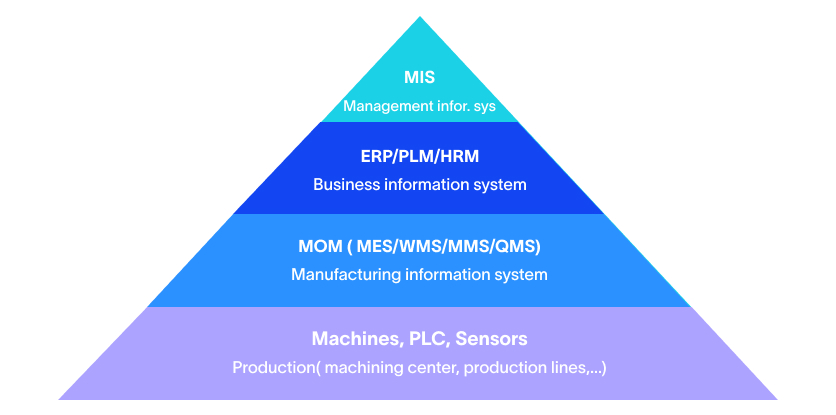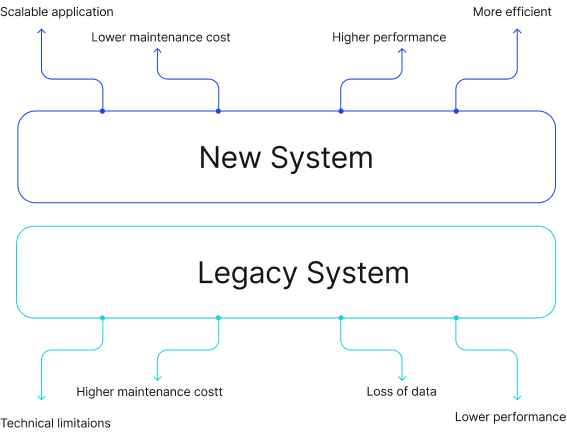MES and ERP Integration for Smart Manufacturing
Blog
3 Min 55 Sec Read
In the data-driven, ever-evolving world of modern manufacturing, the absence of system integration has quietly become the most significant reason for inefficiency.
When your ERP (Enterprise Resource Planning) platform doesn’t properly communicate with your MES (Manufacturing Execution System), even minor disruptions can cause major issues. These may include – blind spots in production, unexpected delays, and rising operational costs.
That’s precisely why we cannot consider MES and ERP integration to be optional anymore. It’s become essential because, by synchronizing your manufacturing execution system, you are not merging two systems together anymore.
You are also developing a unified, intelligent ecosystem – which enables real-time data visibility, coordinates seamlessly across departments, and makes more informed decisions.
So, let’s learn more about it,
From Silos to Seamless: Why MES and ERP Need to Talk
Let’s say, your ERP is scheduling a production run by relying upon outdated inventory data. Meanwhile, the MES on the shop floor starts executing the order. However, at the halfway point, the team hits a wall – because a key material is missing. And your production site grinds to a halt, inventory figures go out of sync, and deliveries are delayed.
So, who’s the real culprit here?
A lack of communication between your manufacturing execution system and enterprise resource planning tools.
Nonetheless, in a well-integrated MES and ERP ecosystem, production orders move much more fluidly from ERP to MES without manual bottlenecks. In this case, material consumption also gets updated instantly. So, if there’s a quality concern on the line, it will trigger real-time scheduling adjustments to take care of it.
As your operators are finishing up batches, live order confirmations are pushed back to the ERP. This allows for accurate inventory counts, smarter fulfillment planning, & better cost analysis.
The seamless interaction is a part of a much larger transformation in modern manufacturing. It works as a shift towards IT/OT convergence. That’s why, instead of operating in silos, enterprise resource planning and manufacturing execution systems are now aligned. This enables faster, data-driven decisions that support smart manufacturing strategies.
Curious how MES transforms operations? Discover the key benefits of MES software for your manufacturing business.
What Does MES Integration with ERP Actually Look Like?
To be clear, MES and ERP integration isn’t only about syncing data between two platforms. It’s about building a closed-loop manufacturing ecosystem – where insights and data flow continuously from the platform to help with business planning and vice versa. Each system strengthens the other in real time. Here’s a simplified version of how this works –
- The ERP system creates a work order.
- That order flows into the MES, which works on execution. This may include – tracking machine activity, operator inputs, production status, in-process quality checks.
- As production progresses, the manufacturing execution system pushes real-time updates back to the ERP—including details like labor hours, scrap quantities, material usage, and order confirmations.
- The enterprise resource planning system, in turn, uses this feedback to update forecasts, reschedule production, and adjust inventory levels with far greater accuracy.
Common Integration Touchpoints:
- Production Orders: Passed from ERP to MES for execution
- Inventory Consumption: Usually recorded in MES and then sent to ERP for planning
- Work Order Completion: Gets confirmed in real time from MES to ERP
- Machine & Operator Performance: Integrated for cost control and advanced analytics
- Quality & Scrap Data: Shared to ensure compliance and maintain traceability
At INS3, we work closely with manufacturers to standardize, map, and automate these critical touchpoints. Using time-tested integration strategies, we help clients achieve real-time, end-to-end production visibility – and, more importantly, tighter collaboration across departments.
Real-Time Visibility Drives Real-Time Decisions
The true value of MES and ERP integration lies in its ability to power real-time, responsive manufacturing. When both systems are working in sync, your team won’t have to guess every second step anymore. They’ll be equipped to act whenever an issue arises.
For example, let’s say, a bottleneck has formed on Line 2. This would be quickly detected by the manufacturing execution system, and you’ll be alerted accordingly. The ERP, on the other hand, responds by adjusting production forecasts and recalculating raw material requirements. Meanwhile customers will get real-time updates on their order status.
This is what happens when you combine real-time production data with connected manufacturing systems. Thanks to it, you are able to shorten the gap between identifying an issue and resolving it accordingly.
The Strategic Role of MES + ERP in Digital Factory Transformation
It’s important to understand that MES integration with ERP is more than just another technical upgrade. It’s a strategic move, especially for manufacturers who are shifting toward digital transformation. Without that integration, businesses’ risk of using disconnected and underused tools become much, much higher than usual.
When properly unified, manufacturing ERP systems and MES platforms act as the backbone of a smart, future-ready factory. Together, they provide real-time feedback loops, unlock predictive insights, and ensure seamless data flow across both the shop floor and the enterprise.
Whether you’re on the path to full IT/OT convergence or just looking to retire manual spreadsheets and reduce order delays, INS3 works with manufacturers to design tailored, scalable solutions – whether for a single facility or an enterprise-wide rollout.
Wherever You are on the MES-to-ERP Journey - INS3 Is Ready to Help
Whether you’re just beginning to explore MES and ERP integration, or you’ve already implemented both systems and want to improve performance, INS3 meets you exactly where you are.
We work with manufacturers to:
- Resolve specific operational challenges
- Extract more value from underused or fragmented systems
- Maximize ROI from existing enterprise resource planning investments
- Build scalable roadmaps for connected, future-ready systems
- Embed real-time production data into planning and analytics workflows
Even if your manufacturing execution system is still in the planning phase, or your ERP is a legacy platform – we develop integration strategies that create tangible progress without requiring a full system overhaul.
With deep experience across platforms like SAP, SAPMES, Microsoft Dynamics, and Oracle, INS3 knows how to connect your factory operations with enterprise-level planning – efficiently, securely, and cost-effectively.
Ready to Close the Gap?
Disconnected systems don’t just limit data, they limit decision-making.
MES integration with ERP empowers manufacturers to respond faster, make smarter decisions, and build more resilient supply chains. By unifying these critical platforms, INS3 helps organizations turn fragmented operations into a seamless, insight-driven manufacturing environment.
From strategic planning to technical implementation, INS3 is your trusted partner in achieving smart manufacturing success.
Want expert guidance as you plan your MES and ERP integration strategy? Reach out to INS3 today. We’re here to help.

Agile MES: The Key to Unlocking Smart Manufacturing Success
MES is a computerized system used in manufacturing operations to track and document the transformation of raw materials into finished goods. An MES system typically manages and monitors work orders, equipment, materials, and personnel on the shop floor. The system provides real-time visibility into production processes, helps optimize manufacturing operations, and improves the overall efficiency of the manufacturing process.

Understanding OEE: The Key to Manufacturing Efficiency
In today’s competitive manufacturing landscape, improving efficiency and productivity is crucial for businesses to remain competitive. One of the key metrics used to measure manufacturing efficiency is OEE or Overall Equipment Effectiveness. In this blog, we will take a closer look at OEE and its importance in manufacturing.

How to Effectively Conduct a Legacy System Integration
Legacy system integration can be a daunting task, but it’s a necessary one for many manufacturers that rely on outdated systems to run their business. Integrating legacy systems with modern technology can improve efficiency, streamline processes, and save time and money. However, it’s important to approach the integration process carefully and methodically to ensure success.
Share on :
Keep On Reading
Subscribe to Our Newsletter
Subscribe to our weekly newsletters to get updates regarding our new production, behind the scene process of our art creation and much more.
After submitting this form you will receive an e-mail with a confirmation link that you must click to complete your request. Detailed information on processing and cancellation can be found in our privacy policy.

